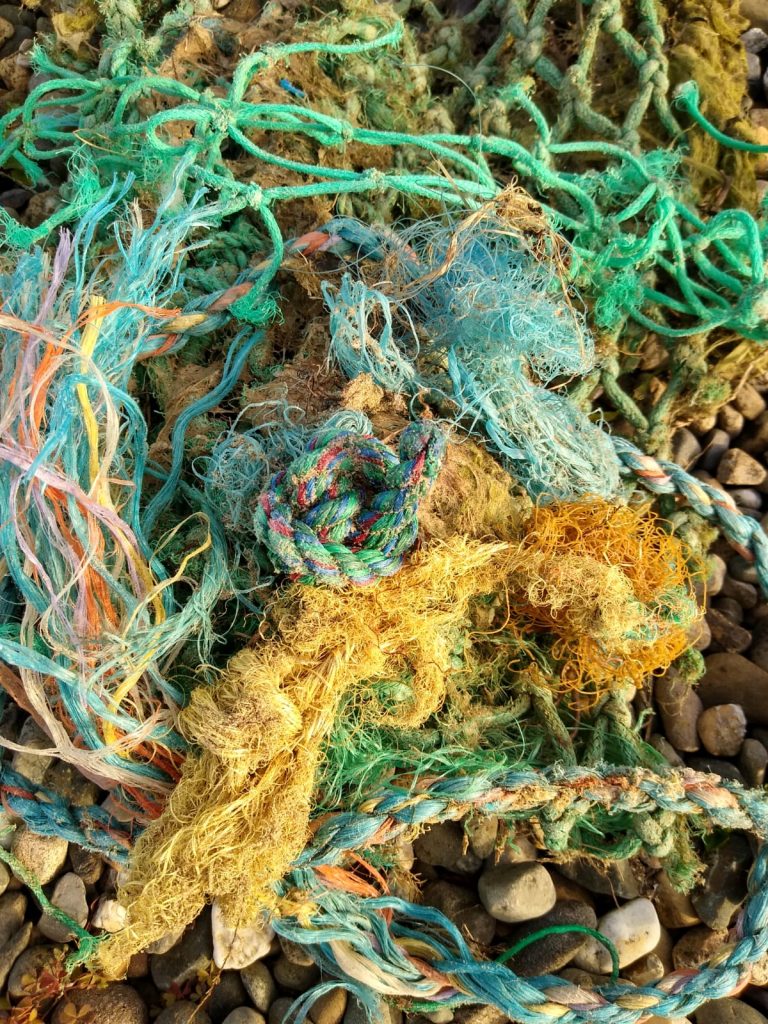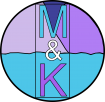I often see glimpses of my favourite colours in the distance when we are walking along the beach…pretty shades of bright or faded blue and green poking out of the sand and waving to us in the wind. We try to dig them out of the sand and pry them out from between rocks to keep them from returning back to the sea where they came from. These bits of rope and netting are referred to as ALDFG, abandoned, lost, or discarded fishing gear, and are a huge source of marine litter.
Approximately one-fifth of all fishing gear in Europe becomes lost at sea due to weather conditions, accidents, marine-life entanglements, or abandonment. It is estimated that there are approximately 11,000 tons of ALDFG found in European waters annually making up about a third of all marine litter in Europe. Worldwide, it is estimated that there are approximately 705,000 tons of ALDFG found annually.
ALDFG is sometimes referred to as ghost fishing. Ghost fishing happens when discarded or lost fishing gear, including nets, ropes, and fishing line, kills or injures marine life. There is no human attached to the ALDFG anymore but because it is out there in the water, it continues to threaten and harm marine life by trapping them, injuring them, suffocating them, or invading their food and habitat sources.
A large portion of ALDFG is netting which is easy for marine animals to become entangled in. The National Marine Fisheries Service reported between 2000 to 2012 there was an average of 11 entangled whales each year along just the west coast of the USA. Similarly, between 2002 and 2010, 32,000 marine animals were found in 870 abandoned nets in just Washington State. Sea Shepherd estimate that 30% of the decline in some fish populations is caused by abandoned fishing equipment. ALDFG kills approximately 136,000 seals, sea lions, and whales annually.
The Skellig Islands, in county Kerry, Ireland, are classified as Important Bird Areas and have large sea bird colonies including the northern gannet. In 2018 on Little Skellig, it was found that the birds are using nylon fishing rope in their nesting. Similarly, Sea Shepherd have estimated that over 90% of deceased sea birds have plastic in their stomachs. Bigger marine animals are ingesting ALDFG too. 13 deceased and stranded sperm whales found in the North Sea in 2015 had fishing nets in their stomachs. ALDFG pose a massive threat to marine life.
On the upside, there are programs in place to try and lessen the abundance of ALDFG found in the wild today. In Ireland, BIM, in cooperation with Clean Coasts, operate a Fishing for Litter initiative to encourage fisherman to take the litter found at sea back to designated ports. The program operates in 12 ports and on 244 boats and has brought back 409 tonnes of marine litter since 2015. Ireland also has a Clean Oceans initiative since 2019 with goals to “aggressively tackle the issue of waste, ghost nets and illegal dumping in the marine environment through rigorous implementation of the Port Reception Facilities Directives and by requiring all Irish Fishing Trawlers to participate in the Clean Oceans Initiative, ensuring that plastic fished up at sea is brought ashore”. Only time will tell if these initiatives will reduce the ALDFG found in our waters.
From a beach cleaning and personal use perspective, ALDFG is generally made out of strong and good quality plastics so, if we can find them and take them home, they can be recycled and reused in many different ways. There are loads of cool companies mending equipment to be used again in fishing or repurposing it for art, swimwear, rugs, bicycle baskets, and more.

When I was a kid I loved crafts and my crafts were always made from whatever we had around or had found somewhere or needed to be reused. I can see the ALDFG being a nice gateway back to that craft life.
Here are some ideas for reusing the ALDFG you find on your next beach clean:
Put a rope on it!
Say bye-bye to putting birds on everything you own, and try wrapping rope around bins, containers, baskets and anything else your heart desires. I particularly like the idea of creating a nautical wreath or holiday garland with bits of salvaged rope to bring a bit of the beach to the holidays.
Here’s some awesome ideas here for wrapping rope and making home and holiday decor: https://www.completely-coastal.com/2013/03/rope-crafts-decor-nautical.html
Rope shelving
I’m really excited to make a rope shelf. I think, based on what we usually find, I will try something small at first.
Here’s a great tutorial for a DIY rope shelf that could be modified for a smaller version: https://www.homedepot.com/c/ah/how-to-make-a-rope-shelf/9ba683603be9fa5395fab90dccb2af7
Jewellery
Some of the rope we find is really pretty and, since its all come from different places, we find a great variety of size and colour. I’d like to try making some bracelets and, luckily, there are loads of cool ideas and tutorials for bracelets made of rope and chord online.
Here’s a few tutorials for little rope bracelets: https://honestlywtf.com/diy/diy-rope-bracelet/ and https://www.triedandtruebytrista.com/how-to-make-nautical-rope-bracelets/
Resources:
https://www.irishexaminer.com/sponsored/arid-40019582.html
https://www.seashepherdglobal.org/latest-news/marine-debris-plastic-fishing-gear/
https://www.seashepherdglobal.org/latest-news/marine-debris-plastic-fishing-gear/

Recent Comments